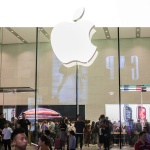Reimagining the role of the store and store associate

The big challenge for retailers is how to reduce their conventional store footprint and headcount while simultaneously delivering improved customer experiences (CX).
The key here is to take a fresh look at both retail spaces and store assistants and how they’re used to drive sales across channels, says Stuart Gordon, UK Country Manager at iAdvize.
Reimagined formats include mixing hospitality elements within traditional stores.
Premium cyclewear brand Rapha is at the front of the pack in this respect. Its Clubhouses can now be found in various formats around the world, mixing omnichannel retail with high-end cafés, a program of live racing, organized rides and events.
As well as conventional Clubhouse stores, Rapha boasts pop-up Clubhouses, mobile units housed in vintage vans and ‘archive’ stores featuring previous seasons’ stock at discount price points.
It isn’t the only brand rethinking the store. Grocery giant Co-op has also been pushing the envelope with its 6,000 sq. ft pop-up shop visiting six UK music festivals during 2019 and four in 2018.
Meanwhile, electronics giant Samsung has opened experience centers where consumers can test drive the firm’s tech but without the option to buy.
These retailers and brands realize that their new store formats, however small, must provide the consumer with an opportunity to shop across a retailer’s channels in a frictionless fashion. To fully achieve this, not only should the store be equipped with the right back-end systems, the store associate should also be equipped with a full range of omnichannel tools.
A drive towards digital
iAdvize research shows that 65 percent of retail leaders are equipping store assistants with a single view of stock across in-store and online inventory. This kind of omnichannel capability is essential if staff are to break down silos and make a valuable contribution to the online customer journey, successfully closing the CX gap, Gordon argues.
Meanwhile, 58 percent of retail leaders want to ‘digitize’ store staff, giving them access to online capabilities (such as online ordering and Click and Collect and personalization), while a similar figure (51 percent) are considering giving staff a 360-degree view of the customer in-store and online.
Fashion proved to be the retail segment most likely to digitize store staff, followed closely by electrical, DIY and homeware and furnishing.
YOU MIGHT LIKE

How can offline retailers meet online expectations?
Opening up omnichannel conversations
Having invested in this level of staff digitization there’s a great opportunity for retailers to unlock employee potential, enabling their people to infuse the full customer journey (both on and offline) with rich, insightful human interaction.
Retailers are increasingly realizing the benefits of using skilled store staff in this way. Two-fifths of retail leaders say they plan to use staff and their excellent product knowledge to engage in online conversational commerce when store footfall is light. This is broken down into 19 percent taking part in live chat and the same number answering online queries, according to iAdvize’s research.
Harvey Nichols is at the vanguard of this movement, enabling online customers to connect in real-time with stylists and product experts from their closest store.
This interaction is achieved via instant messaging and via photo sharing and live video streaming. For Harvey Nichols and other stores eager to capitalise on omnichannel conversational commerce, closing the service gap between online and in-store is a critical part of their strategy.
Retailers are discovering that online conversations with in-store product experts help form an emotional tie between brand and customer, breaking down barriers and encouraging prospects to come in-store to meet the expert, touch and feel the product and discover more.
This not only bridges the CX gap, but it also helps solve the problem of rapidly diminishing store footfall.








